Special Issue IOSOT 2013 - Books and Journals
Special Issue IOSOT 2013 - Books and Journals
Special Issue IOSOT 2013 - Books and Journals
You also want an ePaper? Increase the reach of your titles
YUMPU automatically turns print PDFs into web optimized ePapers that Google loves.
42 S. Japhet / Vetus Testamentum <strong>IOSOT</strong> (<strong>2013</strong>) 36-76<br />
b) In the other pers., although the short form is still more prevalent,32 the<br />
.(ונבנה) 38) Neh. iv 6 (iii ;(ונחנה) full form occurs twice: Ezr. viii 15<br />
It is in Ezr.-Neh., <strong>and</strong> not in Chr. that the general linguistic state is reflected.<br />
The tendency to lengthen the short forms exists, but it is still in its beginnings,<br />
at least in written documents.<br />
ע״ו/ע״י B. Verbs<br />
The process of lengthening the short forms in the impf. cons. is here much less<br />
developed than in ,ל״ה as is shown by the various texts.33 The Chr.’s sources<br />
still preserve the short forms, <strong>and</strong> this is true in general also for Ezr.-Neh. However,<br />
even here the distinctions mentioned above are preserved:<br />
a) The 1 pers. sing. occurs in Chr. only twice. Both instances are taken from his<br />
sources <strong>and</strong> are changed into the full form: 2 Chr. vi 10, 11 (1 Ki. viii, 20, 21).34 All<br />
the other forms in Chr. are short.35<br />
b) In Ezr.-Neh., although the material is meagre, we do find one example of<br />
37.ונשוב (9) 15 the full form:36 Neh. iv<br />
32) But their number in general is of course much smaller than in Chr. We find altogether nine<br />
.ויהי examples of various verbs <strong>and</strong> fifteen times the form<br />
33) Sperber, op. cit., pp. 188 brings only two examples of such a change in the Samaritan Pentateuch,<br />
compared to sixteen in .ל״ה They are: 1) Gen. xxv 17, וימת—MT ;וימות—.Sam 2) Num.<br />
xvii 15: וישב—MT .וישוב—.Sam The examples from the Isaiah Scroll are classified by Kutscher<br />
as orthographic changes (p. 108), <strong>and</strong> here he cites six examples. Kutscher himself is not completely<br />
positive about this classification <strong>and</strong> it seems more likely that the presence of the wāw<br />
is not a sign of introducing the mater lectionis in a short unaccented syllable, but of the shifting<br />
,ויחום—ויחם ,ויעוף—ויעף i.e., forward of the tone, with analogy to the regular forms of the impf.,<br />
etc. If this distinction is right, the place of these examples is really in another paragraph (p. 253).<br />
34) The question is, of course, whether it should rather be classified as an orthographic change<br />
for the syllable is in any case accented. Even so, it serves as an illustration to the consequent use<br />
in Chr.<br />
35) For example: 26—וימת times, four—ויקם times, five—וישם times, 11—וישב times, etc.<br />
ואקום are: 36) The full forms in 1 pers. sing. are more numerous in Ezr.-Neh. than in Chr. They<br />
ויקם .Neh—ואריב xiii 24. In addition to these only the form Neh. ix 15, 15 ,ואשוב (8) 14 Neh. ii 12, iv<br />
is found. (Ezr. iii 2, x 5, 6, 10, Neh. iii 1, ix 4).<br />
37) So the Kethib. The Qre is .ונשב The introduction of the Qre in this matter points no doubt<br />
to a linguistic editing of the text. Other examples of the same type are: (1) Jd. xix 21, Kethib—<br />
וישוב—Kethib (3) Ez. xviii 28, ;ותלש—Qre ,ותלוש—Kethib )2( 2 Sam. xiii 8, ;ויבל—Qre ויבול<br />
.וישב—Qre








![Am HaSefer [Volk des Buches] - Books and Journals](https://img.yumpu.com/20648352/1/174x260/am-hasefer-volk-des-buches-books-and-journals.jpg?quality=85)







